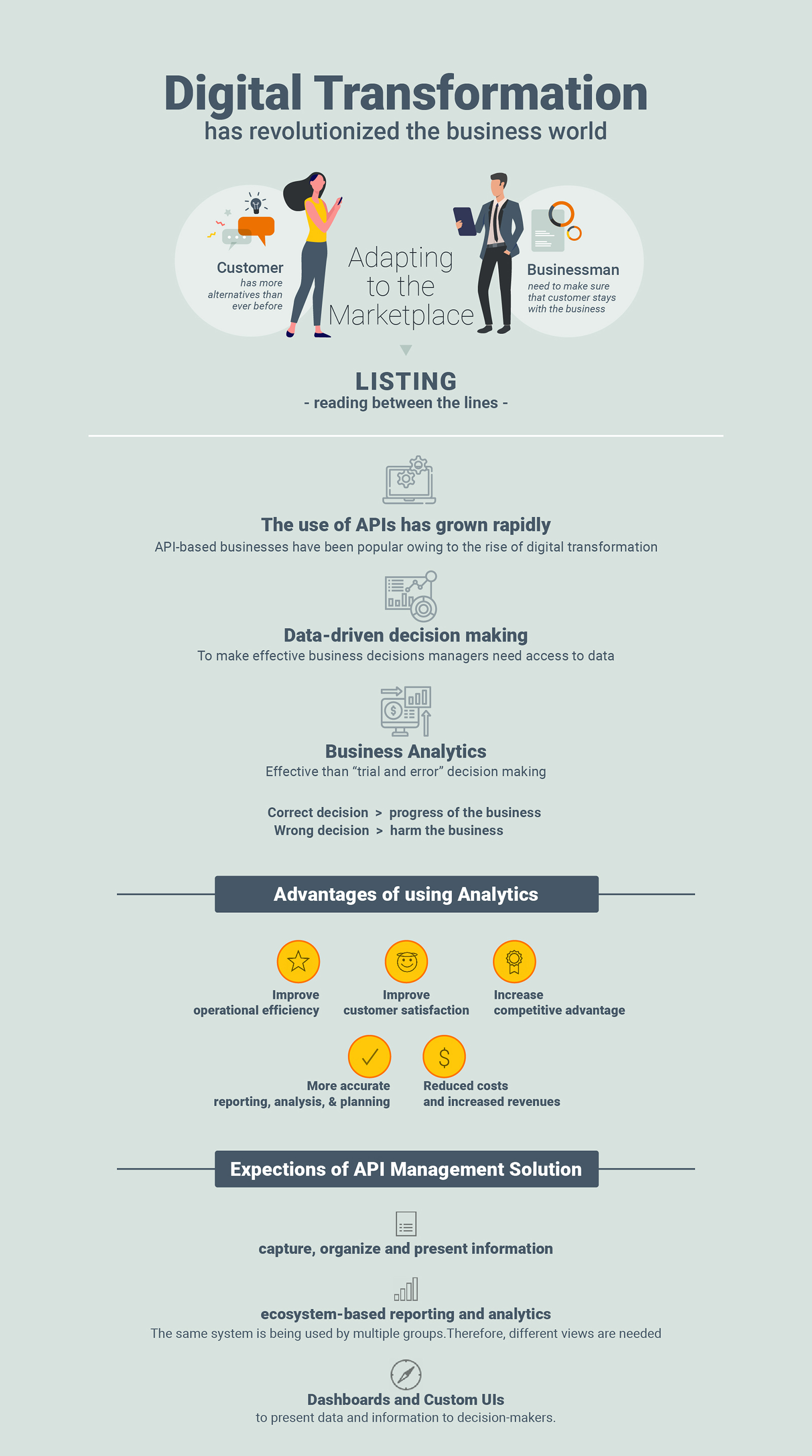API Manager Analytics
Today, data and information have become the new currency. This is invaluable when it comes to the decision-making process in business. Analytics for API management plays a pivotal role in this to ensure that the required information is captured and presented to relevant stakeholders at the right time.
This page discusses how to achieve the above-mentioned business objective in the API management arena. Read our articles below and get a clear idea about it now.
Why Data-driven Decisions are Valuable for the Betterment of the Business
Introduction
Today, the business world is more competitive than ever before and it is struggle to stay ahead of the game. However, if a business is stable today, it doesn’t mean that it will stay there forever.

Why
Because the market and customers are changing; they are demanding more from the service providers. If the business cannot “listen” to what customers “ask”, then it will become a major problem for the business. There are many competitors that are willing to steal customers who are leaving a business that does not listen to them.

It is important to keep an eye on user behavior (both internal and external) and make proactive changes to a company’s operations. This post is about how to achieve that objective in a digitally transforming business.
The Importance of Data-driven Decisions
When running a business, decision making is one of the most important factors that determines the direction of the business. Making the right decision at the right time with the right resources is worth millions of dollars in today’s economy.

In order to do that, decisions have to be made based on actual facts and data. This is called data-driven decision making. A wide range of informative decisions can be made using this method. If this can be done properly, a business can make sure that its limited resources are utilized in the best possible manner. This way, a business will be able to effectively produce the expected results while minimizing the time and resources needed.

If a business fails to steer it using data-driven decisions, there is a large opportunity cost. Making decisions blindly based on assumptions will definitely damage plans. Not knowing how the market and consumers behave is one of the worst things that can happen to a business. In today’s competitive business environment, another company can easily acquire customers who are leaving an ineffective one. This has a direct impact on profitability. Once a customer is dissatisfied, it is hard to get the customer back.
Another fact that deserves attention is how the approach for data analysis will develop over time. Hence, the business should be able to use the latest tools and techniques to capture, record, organize, and present information in a reliable manner. The following are some of the major benefits of having a data-driven approach.
A) Having a data-driven approach will measure how well a business has achieved its vision
In recent years, APIs have become popular. Many business organizations have adopted APIs to expose their functionalities to the outside world. They are able to expand the businesses rapidly with the aid of API based technologies. When this is done, it becomes a pivotal to measure and adjust the performance of the business.
Numbers don’t lie. With the right analytics, management can easily track the progress of the business. This will be beneficial for both internal and external stakeholders. When it comes to internal stakeholders, they can measure how the internal resources are utilized (time, people, infrastructure, etc). They can also monitor how external parties (such as consumers) react to the changes in the business.
B) Making the process more efficient
In order to run the business successfully, it is necessary to identify the factors that affect overall performance. By using reliable analytics, the top and middle managers can identify the performance gaps in the process. To make this more accurate, a company can capture a large amount of data over a period of time and then analyze it to see where the gaps are. This way, management can make necessary adjustments to the process and measure the results. Eventually, they will have the ability to carry out the operations in the most efficient and optimal manner.
C) Keeping up-to-date with the latest demands in the industry/marketplace
Nowadays, a change in any industry can happen at a rapid pace. In today’s business world, it is very important to keep an eye on this because consumers change their minds very quickly and look for the most suitable offer/service. This dynamic nature can be predicted accurately if management keeps a closer look at the changes in consumer behaviors. That is the only way to stay ahead of the game and be the first in the consumer’s mind.
For instance, if the majority of the requests for a particular application comes from Android users, investing more in developing such applications will be beneficial. If an API with an AWS Lambda endpoint has a higher usage, partnering with AWS might help the organization to increase profits.
D) With the right analytics, smart business decisions can be made quickly
There is a significant difference between making a decision based on assumptions and making a decision based on facts. The second method is more accurate and efficient compared to the first approach. Thus, every business tries to rely on decision making that is backed by data and numbers. Using this method, managers can make smart decisions that are beneficial to the business. Also, this process makes sure that the decisions are not based on personal opinions.
Let’s imagine that there is a large consumer base in the EU region (this can be uncovered from the geo-location statistics). When deciding a location for a workshop, decision-makers can take this into consideration and organize the event targeting the best geographical region.
All of the above decisions can be justified using actual facts and information. According to the above, it is clear that businesses need to look at business analytics carefully and make decisions quickly and efficiently. Moreover, these will help to optimize resource allocations, regional marketing activities, and business expansions.
Same Data; Multiple Views: Ecosystem-based Analytics
In the previous sections, we explored the importance of analytics and data-driven decisions. However, different stakeholders will need different views of the same data set to make decisions. For example, when allocating resources for a particular software development project, managers will look at the most demanding services (to allocate people). In the same context, architects are interested in allocating the most suitable physical infrastructure based on the highest user base.

On the other hand, there may be other external parties involved with the business (such as partners). They might be interested in investing in the most profitable product or service that generates the highest ROI.
Therefore, management has to facilitate the requirements of all these parties to keep the business running smoothly. A powerful analytics mechanism is needed to support this requirement, especially in digitally transformed businesses.
This can be considered as the ability to record and present actual data (and information) for the whole ecosystem.
Analytics in a digitally transformed business
If we observe the past decade, we can see that many businesses are using digital transformation to expand their business activities across the globe. Business owners are now able to expand their customer base with the aid of internet and web-based technologies. There are many examples such as eCommerce websites, online stores, online banking, fund transfers, medical reservations, and travel planning. In 2020, most businesses were forced to "go digital" with the spread of Covid-19.

To facilitate this wide range of businesses, there needs to be a way of formalizing business contracts in a digital manner. In other words, service providers should be able to offer their services via an interface that is accessible by their consumers. This is where API management comes into play. With APIs, businesses can easily offer their services (most of them) as a digital agreement between a business and consumers.
If all these pieces are connected together, we can see that the relationship between digital transformation and API-based business models. Those areas are tightly integrated with each other. Hence, to survive in this competitive business environment, organizations should have the right API management in place. If we take one step ahead and think of this in detail, we can identify the importance of data-driven decision making for the betterment of digitally transformed businesses. Therefore, business analytics is one of the key factors that determine the success or failure of a business in the 21st century. Moreover, business analytics becomes a gold mine when it comes to monetizing services.
Summary
Nowadays, the business environment is much more competitive than ever before. There are many competitors in a given industry and consumers are demanding more and more from service providers. To survive in this situation and stay ahead of the game, business organizations have to be reactive to the changes in the marketplace and adjust their operations accordingly.
In this context, business analytics becomes a crucial part of the process. That is the way to make the right decisions at the right time. At the same time, most digitally transformed businesses are relying on API based business models, the need for feature-rich API management solutions has increased rapidly.
Now the time has come to look for better, robust API management solutions that are capable of capturing, organizing, and presenting data and information to the stakeholders of the complete ecosystem.
Making Architectural Decisions With API Analytics
Building, managing, and maintaining APIs is an important process in any API ecosystem. In order to sustain this, you need to have visibility into your APIs and the applications within the ecosystem. Since APIs are being used every day, staying on top of the API program will bring new value to your enterprise. API analytics plays an important part in doing this.
An accurate and reliable analytics system is essential for an API-driven organization. This is a required component of any API management system. An analytics system should be able to collect, analyze, and visualize the collected data by the API ecosystem.
How the Right Analytics Solution Helps Improve Your API Ecosystem
Having the right analytics solution would benefit an API-driven enterprise in many ways. The following are some of the areas that could be improved with an analytics platform.
Resource allocation
Allocating resources properly is one of the critical tasks that affect the well-being of the API ecosystem. The ability to forecast and plan the capacity of the existing system is one of the most important activities for a solution architect. The system should be ‘sized’ according to the need. An oversized system would lead to unnecessary costs to the company and an undersized system would lead to performance degradation and service unavailability.

It is important to have accurate and consistent analytics related to the API ecosystem to take the necessary decisions for planning ahead.
The following are some of the areas related to proper resource allocation that can be improved with the help of a good analytics system.
Even in a well-managed API ecosystem, system downtime is acceptable to some extend. Planned downtime (rolling upgrades, system maintenance windows, etc.) and unplanned downtime (server crashes, API errors, etc.) fall under this section. An analytics solution would help to reduce downtime by providing statistics related to API usage. For example, using API usage-related data, we could plan a specific time of the date to roll out an update to the API or to the API management system. If the number of requests coming to an API is higher than planned (e.g., during the holiday season), we might forecast potential service unavailability and could act on this by scaling the system.
Applying the latest patches and upgrades is crucial to keep the underlying infrastructure robust and secure. Sometimes, while doing this, service interruptions become unavoidable. Knowing about peaks and troughs in traffic help to make the business impact minimal. By going through historical traffic patterns, DevOps engineers can identify times in which traffic is at its lowest and plan infrastructure updates accordingly.
Getting an idea about the peak usage of the APIs is important in designing the API system. Normally system resources are allocated to handle 20-30% more load than the peak load to prevent any hardware-level resource limitations. By using the right analytics solution, a solution architect can come up with the right methods to handle the load.
Improve security of your APIs
Security aspects of the API ecosystem should be continuously validated and evolved. Each day, a new threat would surface to impact the business. Having a check on already identified threats as well as keeping an eye on suspicious behaviors are important in securing APIs. By analyzing the analytics data, we could identify if there are any unrecognized patterns in accessing resources. There could be a high number of unauthorized or throttled out requests that could point out to a potential attack. The analytics system should be able to point out which user or which IP address is doing these requests and relevant parties should be able to take actions based on the data (revoke subscription, block the IP, etc.).
According to the ACFE Report, organizations worldwide lose 5% of their revenue to frauds. Companies try to get the service from fraud detection systems to prevent them. The capability of processing real-time data and identifying any possible fraudulent access patterns would be an added advantage for an analytics platform because it already has the data related to the APIs. WSO2 API Manager Analytics uses predictive analytics techniques, like Markov chains, to identify abnormal access patterns and notify relevant parties. These notifications would be useful in strengthening the security aspects of the whole API ecosystem.
Continuous evolvement of the API ecosystem
A key characteristic of a well-managed API ecosystem is that it improves every day. Publishing a new version of an API to provide a better experience, improve the efficiency of the existing APIs could be seen in this kind of system. API analytics would give a better understanding of how the APIs are performing. For example, if the latency of the API is high, there should be a way to narrow down the bottleneck happening and act on this. This could be done by either increasing the underlying resources or re-designing the API. Analytics data and statistics are useful in understanding user engagement, how they are adapting to specific features (e.g., how well your new GraphQL APIs are performing compared to the REST versions). Moreover, identifying the user and traffic and environment separation, supporting federation, enabling third-party users to access the system, and identifying widely used technologies (such as graphQL and WebSocket) and investing in them can be considered as some other examples.

Some analytics systems provide alerting functionality when different threshold levels exceed during an API invocation path. For example, you would be able to get notifications when API backend response time go over a predefined value, or an API becomes throttled out continuously. Based on this information, an API designer can come up with a better solution to handle these notifications.
An API ecosystem, with a global presence, needs to know where the API calls are originating from. This would help in designing a system to provide a better user experience. For example, having data centers in different regions would reduce the latency for users close to these regions or starting a marketing campaign on regions that has less interaction with the APIs. But what would be the ideal location to have your new datacenters? Where should you start the new marketing campaign? These decisions cannot be made without having API usage data based on geographical locations. It would be ideal if the analytics solution can provide geo-location-based statistics.
How WSO2 API Manager Analytics Can Help You
WSO2 API manager analytics platform is an ideal solution to gain analytics insights to meet enterprise requirements. WSO2’s open-source analytics platform can be seamlessly integrated with WSO2 API Manager and provide statistical data by combining batch, interactive, real-time, and predictive analytics. With the new dashboards to provide more statistical data, WSO2 analytics can be used within different levels of user groups within the organization.
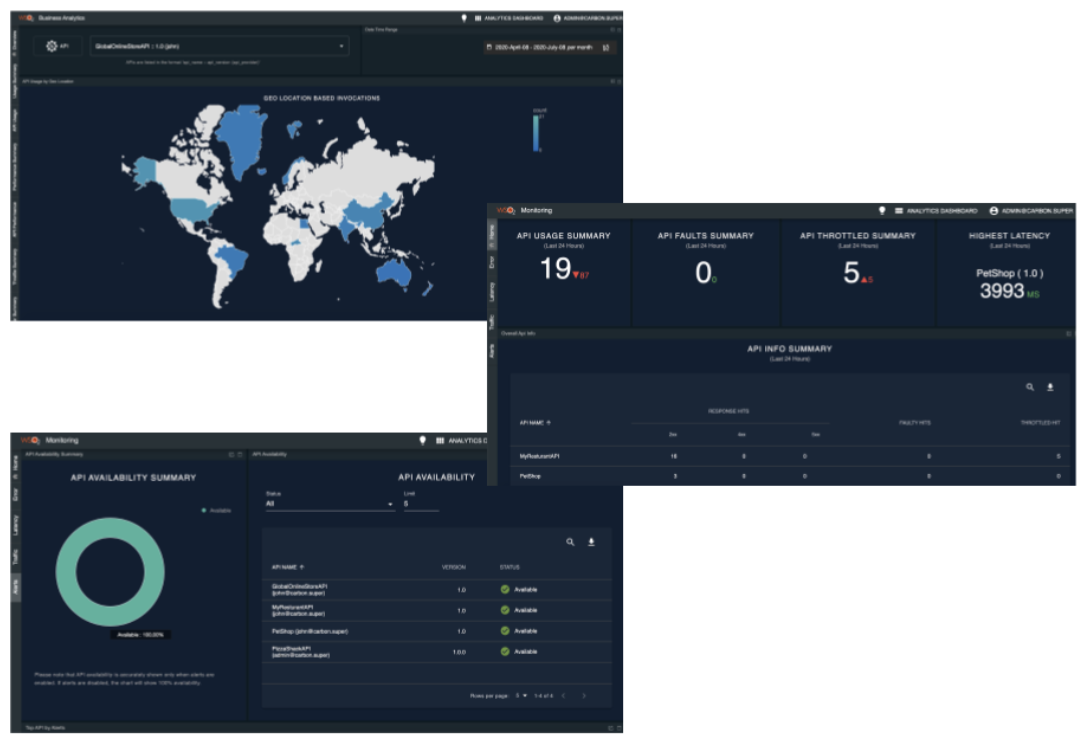
Summary
When you have a good API program, innovative ideas are limitless. Making improvements to the API ecosystem requires statistics from good analytics solutions. An API management system with an analytics solution is essential for this.
Build a Better Version of Your API with API Analytics
Why is a Proper Analytics Solution Needed?
Having a good analytics platform in an API management ecosystem is crucial for any enterprise that runs an API management system. This is the main method to find out how APIs are behaving. Having accurate data on API usage can help to make decisions about the company’s well-being. Having a rich data set generated from an API management system would be beneficial for many user groups. Having a good set of data on how APIs behave will help in many decision-making processes. The growth of the business will be highly dependant on having accurate data on how your APIs perform and how users interact with them.

How Developers Benefit from API Analytics
Developers are mainly engaged at the ecosystem’s ground level. However, they are the ones who build awesome APIs and the applications that use them. Developers cannot stop the work completely even after creating the APIs and the application. They need to keep on evolving the APIs based on the feedback given by the users. Having statistics on how APIs and applications perform can help them to improve their APIs and develop applications iteratively.
There are two main developer categories in any API ecosystem.
- API developers
- Application developers
Each of these groups benefits from a well-informative analytics system that is plugged into an API management solution.
API developers
The heart and soul of an API management system are the APIs that expose it. These APIs need to evolve with time. Analytics plays a major role in the iterative development and evolution of these APIs.
One of the key features of an API management system is having a versioning capability for APIs. API developers can improve their APIs and release a new version of the same API. Some of these improvements could be in the form of updating security policies, improving performance on the customization, bug fixes, etc. Most of these changes are based on API usage observations. Having an analytics system that can provide detailed information on each API component can be significantly helpful for an API development team in making those decisions.
For example, if a customized extension is plugged into an API request/response path and if it is adding additional latency, API developers should be aware of it so that they can publish a better version of the API by rectifying the issues. If the API is having a large number of throttled out requests, API developers need to know about this so that they can introduce a new throttling plan. If the backends are producing a high number of errors, API developers would want to be aware so that they could take action on this (add load balancing endpoints to the API, set a peak limit on the backend service to prevent outages, etc). A good analytics system should be capable of providing this kind of information so that API developers can improve their APIs.
If the APIs are performing badly and one needs to decommission an API or if it is the time to retire an older version, developers can make these decisions based on the data coming from the analytics platform.
WSO2 API Manager Analytics is a product that provides these capabilities. For example, it can be used to obtain a drilled-down latency graph for requests showing latencies for major components in the request path (e.g., latency for handlers, custom mediation sequences, backend, etc). Moreover, it is possible to compare statistics between the version of a given API. Additional graphs are provided to monitor faults and throttled out requests. Some widely used graphs are shown below. The full set of graphs can be found in the official documentation.
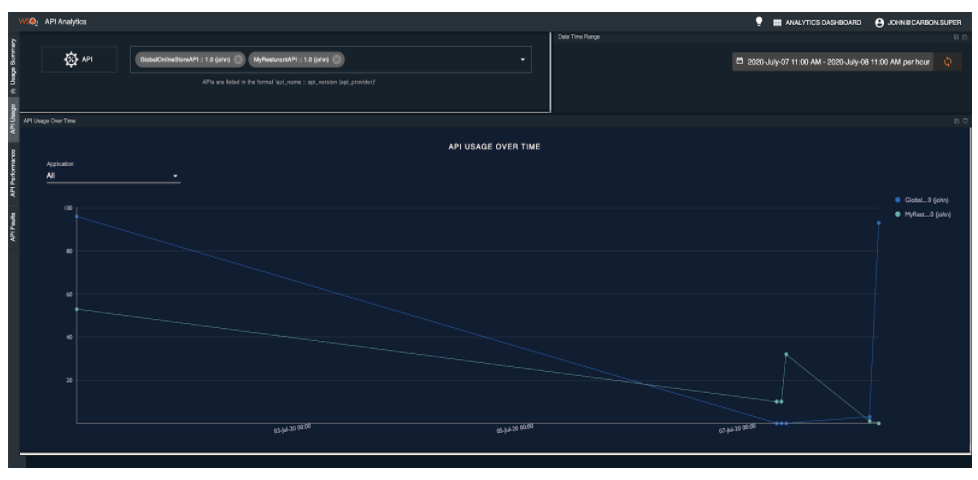
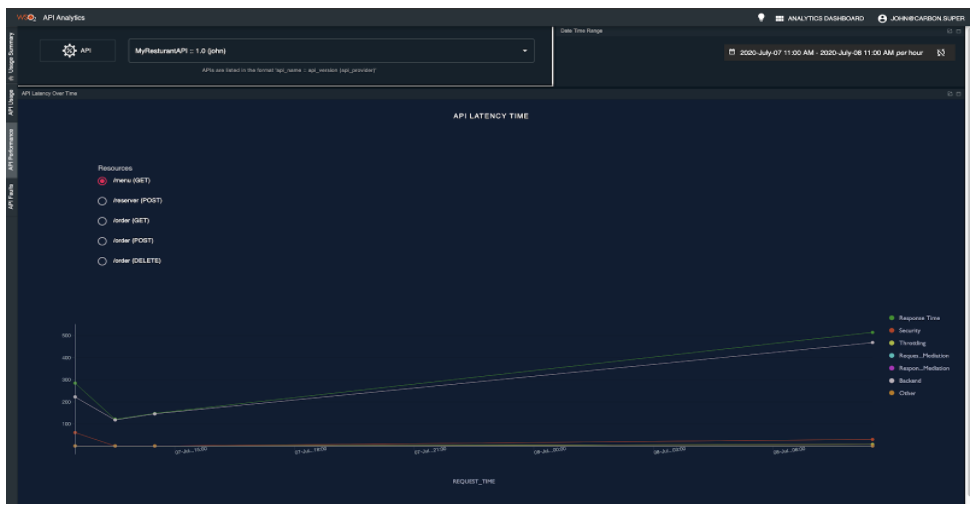
Application developers
Application developers build interesting applications on top of the APIs exposed in the API system and help to bring in revenue for your business. They need to have access to the statistics of their applications in order to make decisions. They should be able to see the usage of their application and the number of users who are using this. Based on the data received, they could decide on the tier plans, how to improve his application, etc. For example, Google Play Store applications developers can view the number of downloads.
Based on this insight, it is possible to decide on how to introduce a newer version of the application with additional revenue generation methods.
For application developers, WSO2 Analytics provides separate sets of data such as application user information, API resource usage, faulty invocation information, etc.
More information on this can be found in the official documentation as well.
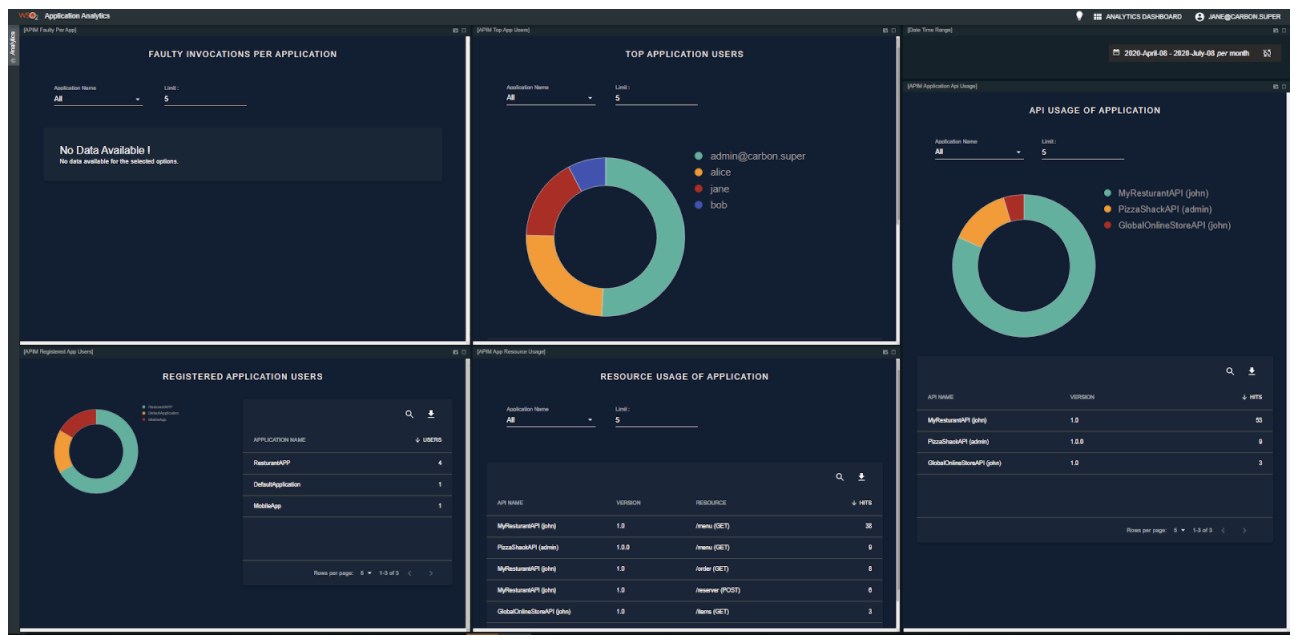
Real-time Alerts Keep to the Developers on Edge

In the middle of the night, if an API starts to throw errors and if the respective API owners only get to know about it in the morning, the company might have lost millions in revenue. This is why enterprises need a robust alerting system. Having a real-time alerting solution in your API manager solution is essential because each second matters.
A good alerting solution helps an organization to identify any real-time issues or potential issues that might occur related to APIs and applications. If the backends are down, developers need to act immediately. Or if the APIs or applications are getting throttled out frequently, app developers or API developers need to come up with a better tier plan for it. Some advanced alerting systems even recognize possible malicious invocation patterns based on past data and notify relevant parties.
WSO2 Analytics comes with in-built real-time analytics features. It can generate alerts for API availability, frequent tier limit breaches, and abnormal response times. API developers and application developers can fine-tune the threshold values so that each type of alert is generated when they exceed the pre-configured threshold. A set of emails can be configured for each alert to notify the responsible parties.
Refer to the documentation for API-based alerts.

Summary
An accurate and reliable analytics solution is required for an API management system. Having a reliable set of data related to the APIs and the activities that happened around the APIs are essential in making decisions within an API-driven organization. API and application developers, who interact with the APIs in the API platform, can benefit from having access to API statistics. Having access to a detailed dataset can help developers to improve their APIs and act on any potential issues and early warnings.
The Role of API Analytics in Digital Transformation
